Search results for: 'Art'
-
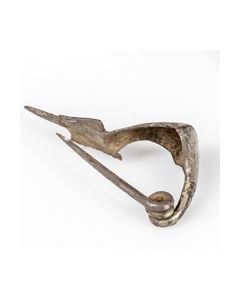 Greek fibula from colonies in Southern Italy
Greek fibula from colonies in Southern ItalyNice silver brooch from the colonies in Southern Italy. Late classical to early hellenistic period.
Price: on request Early fibula from Magna Graecia
Early fibula from Magna GraeciaGreek silver brooch and piece of jewellery from the South Italian colonies. Geometric period.
Price: on request Etruscan "a baule" type earrings
Etruscan "a baule" type earringsSkilfully made pair of gold earrings with filigree. The ancient jewellery is from the Golden Age of the Etruscans around the 6th century BC.
Price: on request Egyptian bronze figurine of Isis with Horus
Egyptian bronze figurine of Isis with HorusIsis is shown in a very typical depiction as a mother, the archetype of the later Christian Nursing Madonna. This bronze figurine comes from an old museum collection.
Price: on request Roman silver knee brooch
Roman silver knee broochNice specimen with characteristic bend in its bow and incised decorations. From the Danubian provinces of the Roman Empire.
Price: on request Etruscan "a baule" type earrings
Etruscan "a baule" type earringsSkilfully made pair of gold earrings with filigree. The ancient jewellery is from the Golden Age of the Etruscans around the 6th century BC.
Price: on request Side frame of a Roman stool
Side frame of a Roman stoolPiece of a seating furniture with elaborate openwork designs. The fantastic state of preservation is known from other bronze stools found in Pompeii and the area around Mount Vesuvius.
€14,100 Mosaic glass inlay with half mask
Mosaic glass inlay with half maskSkillfully arranged motif that could be combined with a plate of the same motif to show a full face. Made in Egypt during the early Roman Imperial period.
€4,700 Roman anchor fibula
Roman anchor fibulaMagnificent silver brooch from the Roman Imperial period. Such fibulae were made in the Danube area Roman provinces.
Price: on request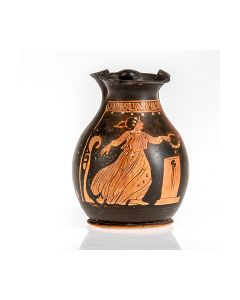 Apulian oinochoe with dancing maenad
Apulian oinochoe with dancing maenadPerfectly preserved including the painting. Worth the exhibition in a museum. From an old German collection, acquired 1977 at Kunsthandlung Aloys Faust, Cologne.
Price: on request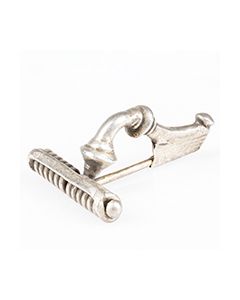 Roman silver fibula
Roman silver fibulaBeautiful brooch from the eastern Roman provinces. Remains of an original gold plating can still be seen on the surface.
Price: on request Gruppe von 3 Bronzefibeln
Gruppe von 3 Bronzefibeln800 v.Chr. bis 300 n.Chr. , Eisenzeit. Diverse Typen einschließlich hellenistischer und römischer Fibeln. Nadeln fehlend oder restauriert.
Price: on request Necklace of ancient eye beads
Necklace of ancient eye beadsModernly threaded necklace made of more than 100 ancients beads dating to the 1st millennium BC. From the eastern Mediterranean. Ex Christie's.
Price: on request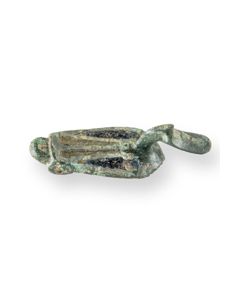 Bird brooch from Roman Britain
Bird brooch from Roman BritainNice fibula in the shape of a stylized water bird. A find from Britain and probably also a local Roman provincial production.
Price: on request Four Scythian arrow heads
Four Scythian arrow headsGroup of four arrowheads made of bronze in excellent condition. Popular weapon of the cultures of the 1st Millennium BC.
€240 Four Scythian arrow heads
Four Scythian arrow headsGroup of four arrowheads made of bronze in excellent condition. Popular weapon of the cultures of the 1st Millennium BC.
€240 Roman plate brooch
Roman plate broochBeautiful example with orange and turquoise enamel. A find from 2nd century Roman Britain.
Price: on request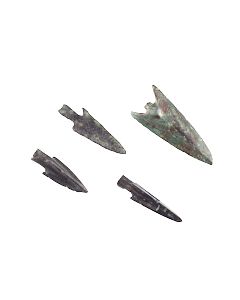 Four Scythian arrow heads
Four Scythian arrow headsGroup of four arrowheads made of bronze in excellent condition. Popular weapon of the cultures of the 1st Millennium BC.
€240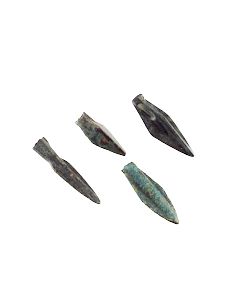 Four Scythian arrow heads
Four Scythian arrow headsGroup of four arrowheads made of bronze in excellent condition. Popular weapon of the cultures of the 1st Millennium BC.
€240 Large clay figure of Aphrodite Anadyomene type
Large clay figure of Aphrodite Anadyomene typeVery impressive, 27 cm high elegant figure. The goddess is rising from the sea, setting her foot on a stone and leaning on a high column.
Price: on request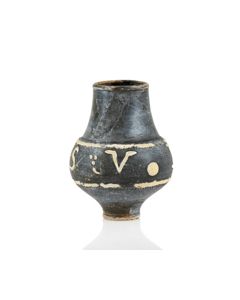 Roman terracotta beaker from the Rhineland with painted inscription
Roman terracotta beaker from the Rhineland with painted inscriptionThe insciption VIVAS (live!) in intense white color is perfectly preserved. Found near the Roman city of Novaesium, today's Neuss in Germany, an early Roman foundation and with this one of the oldest cities in Germany.
Price: on request Roman seal box with phallus
Roman seal box with phallusCircular body with protective phallus in high relief on the lid. A piece from the Roman Imperial period, found in North East England. Published in a standard work by Richard Hattatt.
Price: on request Ptolemaic sarcophagus mask
Ptolemaic sarcophagus maskImpressive wood relief of an idealized face. Remains of paint. The mask was part of a sarcophagus lid from Ancient Egypt during ptolemaic rule.
Price: on request Greek fibula from Italy
Greek fibula from ItalyLovely silver brooch from the Greek colonies in Southern Italy. Late classical to early hellenistic period.
€690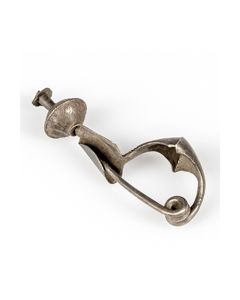 Greek fibula from the colonies in Southern Italy
Greek fibula from the colonies in Southern ItalyLovely silver brooch and piece of jewellery. Late classical to early hellenistic period.
€750 Greek fibula from the colonies in Southern Italy
Greek fibula from the colonies in Southern ItalySilver brooch in near perfect condition. Late classical to early hellenistic period.
Price: on request Tanagra figure of a bride from Henry H. Gorringe collection
Tanagra figure of a bride from Henry H. Gorringe collectionHenry Honychurch Gorringe (1841-1885) was responsible for the removal of Cleopatra's Needle from Alexandria, Egypt to Central Park in New York City.
Price: on request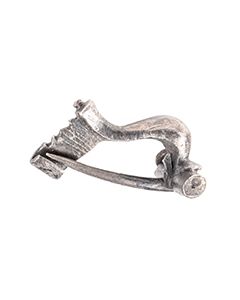 Roman silver knee brooch
Roman silver knee broochNice specimen with characteristic bend in its bow and attached loop and ring. From the Danubian provinces of the Roman Empire.
Price: on request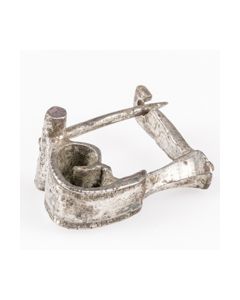 Roman silver fibula from Pannonia
Roman silver fibula from PannoniaInteresting brooch type from the Roman Pannonian provinces. A very similar piece was found near the Roman camp and settlement of Carnuntum in what is now Austria.
Price: on request Pannonian trumpet brooch
Pannonian trumpet broochWell preserved Roman silver fibula with curved bow. The type is from the Pannonian provinces of Rome and dates to the 2nd century.
Price: on request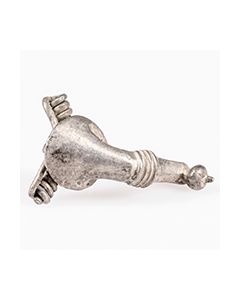 Pannonian trumpet brooch
Pannonian trumpet broochWell preserved Roman fibula made of silver. The type is from the Pannonian provinces of Rome and dates to the 2nd century.
Price: on request Daunian jug with high handle
Daunian jug with high handleItalic pottery in the subgeometric style. Made around 500 BC in Apulia. Handled vessels of this type are an guiding form in Apulian archaeology.
Price: on request Gallo-Roman animal fibula
Gallo-Roman animal fibulaZoomorphe Fibel mit Wildtier als Motiv. Schmuckstück mit religiöser Symbolik, vergleichbar einem Kreuzanhänger bei heutigen Christen. Gefertigt im 1. bis 3. Jh. n. Chr. in Gallien.
Price: on request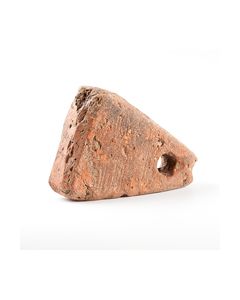 Roman clay loom weight
Roman clay loom weightMassives Gewicht aus Terrakotta mit Öse zur Aufhängung als Webgewicht, aus der römischen Kaiserzeit, Germanische Provinzen, 1. bis 2. Jh. n. Chr.
Price: on request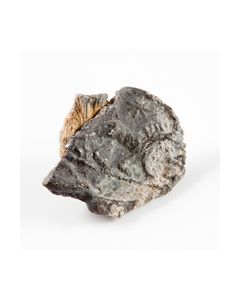 Siegelabdruck mit Resten von Flachs
Siegelabdruck mit Resten von FlachsAbdruck eines Siegels in Blei mit schreitendem Löwen, darüber ein Stern. Hellenistische Zeit, 2. Jh. v. Chr., aus Miletos. Außerordentlich selten ist der erhaltene Rest von antikem Flachs!
Price: on request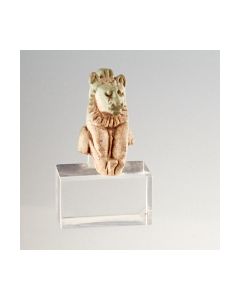 Egyptian amulet of a lion headed goddess
Egyptian amulet of a lion headed goddessAttributed to Sekhmet, goddess of war and protection from illness. Very nice and detailed fayence work. Dating to the Third Intermediate Period to Late Period of Ancient Egypt.
Price: on request

